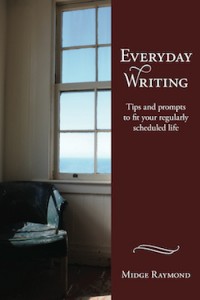A version of this interview appeared initially in The Practicing Writer, June 2012.
I have admired Midge Raymond’s fiction for years. More recently, I’ve become a fan of her blog and its reliably sound advice for writers. So when I learned that Midge was releasing a book titled EVERYDAY WRITING: TIPS AND PROMPTS TO FIT YOUR REGULARLY SCHEDULED LIFE, I was intrigued. And I was thrilled to be offered a review copy.
 Midge Raymond’s short-story collection, FORGETTING ENGLISH, won the Spokane Prize for Short Fiction. Her work has received several Pushcart Prize nominations and an Artist Trust/Washington State Arts Commission Fellowship. Midge taught communication writing at Boston University for six years, and she has taught creative writing at Boston’s Grub Street Writers and Seattle’s Richard Hugo House. While living in Southern California, she held writing workshops and seminars at San Diego Writers, Ink, where she also served as vice president of the board of directors. Midge lives in the Pacific Northwest, where she is co-founder of the boutique publisher Ashland Creek Press (which is the publisher of EVERYDAY WRITING).
Midge Raymond’s short-story collection, FORGETTING ENGLISH, won the Spokane Prize for Short Fiction. Her work has received several Pushcart Prize nominations and an Artist Trust/Washington State Arts Commission Fellowship. Midge taught communication writing at Boston University for six years, and she has taught creative writing at Boston’s Grub Street Writers and Seattle’s Richard Hugo House. While living in Southern California, she held writing workshops and seminars at San Diego Writers, Ink, where she also served as vice president of the board of directors. Midge lives in the Pacific Northwest, where she is co-founder of the boutique publisher Ashland Creek Press (which is the publisher of EVERYDAY WRITING).
I’m delighted to welcome Midge Raymond here to answer a few questions about her new book.
Erika Dreifus (ED): Midge, you’re an award-winning author known especially for your short stories. What made you want to write a book *about* writing?
Midge Raymond (MR): I was inspired to write EVERYDAY WRITING because I’ve had to build a writing practice around my regularly scheduled life – and in the past, due to the “write every day” adage we all hear so often, I felt that I wasn’t a “real” writer. Yet while I’ve never been able to write every single day, over the years I’ve managed to publish many stories and eventually a book – so I wanted to create something to encourage other writers who are told to write every day that they don’t actually need to do this in order to succeed. All they need to do is to create a plan that works for them.
Also, because I’ve taught creative writing for nearly 15 years, I’ve spent a lot of time coming up with writing prompts for classes. I’ve found that these exercises are as useful to me as I hope they are to my students; I turn to prompts all the time, both mine and others’, to get me through a scene or to jump-start a new project. Writing prompts are wonderful for the busy writer: They give you an instant place to begin, and you can either start something brand-new or apply them to a project you’re hoping to finish.
ED: Along some of those lines, early in the book, you state: “I don’t subscribe to the notion that if we don’t sit down to write every day, we’ll never accomplish anything–and yet writers are often told just that, in various ways.” Which may make some people wonder: How can one be an Everyday Writer without writing everyday?
MR: For me, being an Everyday Writer means thinking like a writer – and this we can all do on a daily basis, even if we don’t have time to sit down to write. I had an eye-opening experience a couple years ago while I was meeting a friend for drinks in Seattle – I was early, and I found myself turning to my cell phone to keep myself busy, realizing only afterward that I’d wasted precious time checking my email and playing Words with Friends. I looked up from my phone at one point and saw what I was missing: a couple having a whispered argument, all sorts of interesting people coming and going – these are the things writers should pay attention to. Many of my stories have been inspired by an overheard bit of dialogue or by a glimpse of something intriguing – and yet here I was with my cell phone taking me away from all these possibilities. So I’ve made an effort to keep the phone tucked away and to pay attention to the world around me.
Another way to be an Everyday Writer is to carry a notebook and use it. I prefer a real notebook, a pad and pen – this way, I don’t get tempted to check email! This isn’t a writing practice but simply a good habit for a writer to have. My mind is such that if I don’t write something down instantly, it’s gone forever, so I try to jot down anything that catches my attention, from an outfit to a tattoo to an interaction between people. I’ve found scribbled notes months or even years after I’ve written them, and I’ve created a good number of stories from these scribbles. It’s often even better to find them after time goes by; it’s not the context that’s important or relevant but what inspired me to write it down – that’s the part that’s worth exploring. The more often a writer does this, the more material she’ll have when she does sit down to write.
ED: The book is divided into two parts: “Becoming an everyday writer” and “Writing exercises.” Readers of my Practicing Writing blog may already know that I’m a huge fan of your writing exercises. But the book’s further categorization of “situational prompts” and other writing prompts was new to me. Tell us what makes a prompt “situational” and how you envision all the different categories in this section of the book working together.
MR: My goal with the “situational” prompts is to offer a way for writers to get into the think-like-a-writer mindset and to look at every moment as a writing opportunity. If, for example, you’re waiting for your coffee to brew, consciously think about coffee: the sounds, scents, and emotions it brings to mind. Capture images, sensations, and feelings – these mental notes can be applied to a character in a current writing project, or they can be used to spark something new. The idea is to use this normally idle time as “writing time.” Similarly, if you’re in an airport – one of the best places in the world for people watching – instead of talking on the phone or reading a magazine, take out a notebook and describe what’s happening around you. I’m working on a story right now that’s based on something I heard over the PA system the last time I was in an airport. Inspiration is everywhere – we just have to train ourselves to see it.
ED: By the time readers see this interview, you’ll have taught a couple of workshops in San Diego on the “Everyday Writing” theme. Please tell us a bit about the structure and content of those workshops.
MR: The Everyday Writing–themed workshops will be very hands-on. My plan is to get writers organized the way we know we should be but aren’t often able to accomplish. So the workshops begin by asking writers to take a look at their current writing lives, assessing everything about their process to see what they have already and what they still need. Then we work on aligning these in a way that allows writers to create a schedule that works for them and helps them meet their writing goals.
Often when we don’t have enough time to write, we get discouraged and give up – especially if we’re told we must write every day and can’t – but in fact writers can accomplish amazing things as long as they figure out what they want and how to fit it in. So we work on individual writing schedules, on realistic goals, and on how to be flexible moving forward. Then we’ll do a series of prompts to kick-start new projects as well as to start the training process for how to be an everyday writer. [ED note: Check http://www.midgeraymond.com/news.html for news about other forthcoming workshops and presentations that Midge will be offering.]
ED: Finally, please tell us a bit about Ashland Creek Press, which is publishing EVERYDAY WRITING.
MR: I co-founded Ashland Creek Press along with my husband, John Yunker, last year, after he decided to self-publish his book THE TOURIST TRAIL, which had found a terrific agent but no home among major publishers. Due to the changes in the economy as well as the publishing industry, we began to wonder how many books were having similar trouble finding homes, and we wanted to provide that home for them. We’ve been amazed and inspired by the quality of the submissions we’re receiving, and by the end of 2012 we’ll have published six novels, ranging from literary novels to an environmental vampire trilogy to an eco-mystery.
I decided to publish EVERYDAY WRITING with Ashland Creek Press rather than pursue another publisher because I liked the idea of getting it into the world sooner than later and being able to manage it myself. And I was fortunate to have a great book designer and wonderful readers and editors to help me along the way.
ED: Thanks so much, Midge. EVERYDAY WRITING is a terrific book. Here’s to its success!
To learn more about EVERYDAY WRITING, please visit http://ashlandcreekpress.com/books/everydaywriting.html